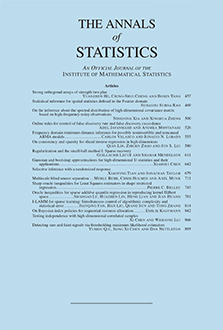Abstract
The difficulties of estimating and representing the distributions of functional data mean that principal component methods play a substantially greater role in functional data analysis than in more conventional finite-dimensional settings. Local maxima and minima in principal component functions are of direct importance; they indicate places in the domain of a random function where influence on the function value tends to be relatively strong but of opposite sign. We explore statistical properties of the relationship between extrema of empirical principal component functions, and their counterparts for the true principal component functions. It is shown that empirical principal component funcions have relatively little trouble capturing conventional extrema, but can experience difficulty distinguishing a “shoulder” in a curve from a small bump. For example, when the true principal component function has a shoulder, the probability that the empirical principal component function has instead a bump is approximately equal to ½. We suggest and describe the performance of bootstrap methods for assessing the strength of extrema. It is shown that the subsample bootstrap is more effective than the standard bootstrap in this regard. A “bootstrap likelihood” is proposed for measuring extremum strength. Exploratory numerical methods are suggested.
Citation
Peter Hall. Céline Vial. "Assessing extrema of empirical principal component functions." Ann. Statist. 34 (3) 1518 - 1544, June 2006. https://doi.org/10.1214/009053606000000371
Information





